
Browse an alphabetical list of photographs. These historical images portray people, places, and events before, during, and after World War II and the Holocaust.
<< Previous | Displaying results 1251-1300 of 2641 for "Photo" | Next >>
Insignia of the 30th Infantry Division. The nickname of the 30th Division was Old Hickory, named after President Andrew Jackson.
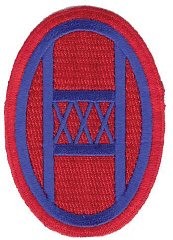
Insignia of the 36th Infantry Division. The 36th Infantry Division, the "Texas" division, was raised from National Guard units from Texas and Oklahoma during World War I. The "T" in the division's insignia represents Texas, the arrowhead Oklahoma. The division was also sometimes called the "Lone Star" division, again symbolizing its Texas roots.
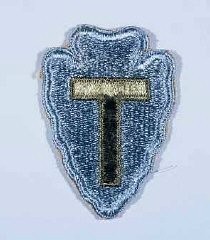
Insignia of the 3rd Armored Division. "Spearhead" was adopted as the nickname of the 3rd Armored Division in recognition of the division's role as the "spearhead" of many attacks during the liberation of France in 1944.

Insignia of the 42nd Infantry Division. The nickname of the 42nd Infantry Division, the "Rainbow" division, reflects the composition of the division during World War I. The division was drawn from the National Guards of 26 states and the District of Columbia. It represented a cross section of the American people, as the rainbow represents a cross section of colors.
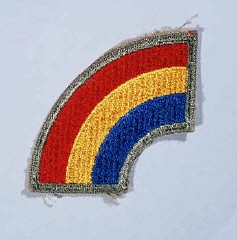
Insignia of the 45th Infantry Division. The 45th Infantry Division gained its nickname, "Thunderbird" division, from the gold thunderbird. This Native American symbol became the division's insignia in 1939. It replaced another previously used Native American symbol, a swastika, that was withdrawn when it became closely associated with the Nazi Party.
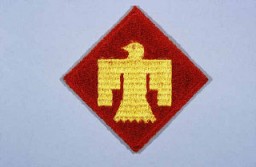
Insignia of the 4th Armored Division. The commanding general of the 4th Armored Division refused to sanction an official nickname for the 4th, believing that the division's accomplishments on the battlefield made one unnecessary. "Breakthrough" was occasionally used, apparently to highlight the division's prominent role in the breakout from the Normandy beachhead and liberation of France in 1944.
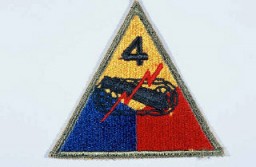
Insignia of the 4th Infantry Division. The 4th Infantry Division's nickname, the "Ivy" division, is derived from the divisional insignia developed during World War I: four ivy leaves on a diamond field, symbolizing the roman numeral "IV."
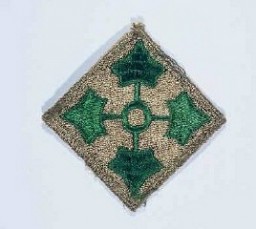
Insignia of the 63rd Infantry Division. The 63rd Infantry Division was nicknamed the "Blood and Fire" division soon after its formation in the spring of 1943. The nickname commemorates British prime minister Winston Churchill's statement at the Casablanca Conference in January 1943 that "the enemy would bleed and burn in expiation of their crimes against humanity." The divisional insignia illustrates the nickname.
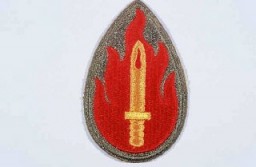
Insignia of the 65th Infantry Division. The 65th Infantry Division was nicknamed the "Battle Axe" after the divisional insignia, a halbert (an axe on a pole), used to cut through the enemy during medieval times.

Insignia of the 69th Infantry Division. The 69th Infantry Division gained the nickname the "Fighting 69th" during World War II. The name has no heraldic significance, but simply conveys the esprit de corps of the division.
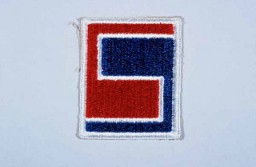
Insignia of the 6th Armored Division. "Super Sixth" became the nickname of the 6th Armored Division while the division was training in the United States, apparently to symbolize the division's spirit.
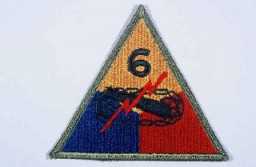
Insignia of the 71st Infantry Division. The nickname of the 71st Infantry Division, the "Red Circle" division, is based upon the divisional insignia (which includes a red circle).
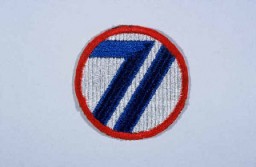
Insignia of the 80th Infantry Division. The nickname of the 80th Infantry Division, the "Blue Ridge" division, reflects the home states of the majority of soldiers who formed the division during World War I: Pennsylvania, West Virginia, and Virginia. The Blue Ridge Mountains run through these three states.
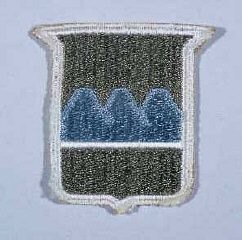
Insignia of the 82nd Airborne Division. The nickname for the 82nd Airborne Division originated in World War I, signifying the "All American" composition of its members. The troops who formed the division came from diverse areas of the United States.
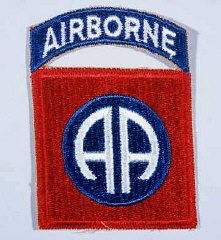
Insignia of the 83rd Infantry Division. The 83rd Infantry Division received its nickname, the "Thunderbolt" division, after a division-wide contest for a new nickname held in early 1945. The earlier nickname, "Ohio," was based on the division's insignia (which includes the name "Ohio," where the division was raised during World War I). A new nickname was desired to represent the nationwide origins of the division's personnel during World War II.
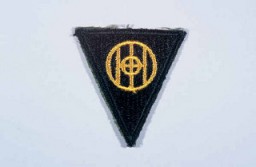
Insignia of the 84th Infantry Division. The 84th Infantry Division derives its nickname, "Railsplitter" division, from the divisional insignia, an ax splitting a rail. This design was created during World War I, when the division was known as the "Lincoln" division to represent the states that supplied soldiers for the division: Illinois, Indiana, and Kentucky. All figured prominently in the life of President Abraham Lincoln, of log-splitting legend.

Insignia of the 86th Infantry Division. The 86th Infantry Division developed the blackhawk as its insignia during World War I, to honor the Native American warrior of that name who fought the US Army in Illinois and Wisconsin during the early nineteenth century. The nickname "The Blackhawks" or "Blackhawk" division is derived from the insignia.
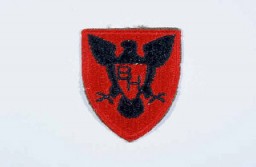
Insignia of the 89th Infantry Division. The 89th Infantry Division's nickname, the "Rolling W," is based on the division's insignia. Created during World War I, this insignia utilized a letter "M" inside a wheel. When the wheel turns, the "M" becomes a "W." The letters "MW" signify the mid-west origin of the troops who formed the 89th during World War I. The division was also known as the "Middle West" division, another variation on its origin.
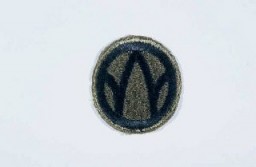
Insignia of the 8th Armored Division. The nickname of the 8th Armored Division, the "Thundering Herd," was coined before the division went to Europe in late 1944. It was also known as the "Iron Snake" late in the war, after a correspondent for Newsweek likened the 8th to a "great ironclad snake" as it crossed the Rhine River in late March 1945.
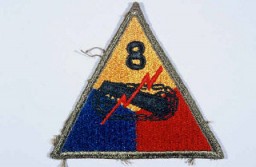
Insignia of the 8th Infantry Division. The 8th Infantry Division was known as both the "Golden Arrow" and "Pathfinder" division during World War II. Both nicknames originated from the division's insignia, which includes a gold arrow to represent the nineteenth century explorer of California, John Fremont. The division was formed in California in 1918.

Insignia of the 90th Infantry Division. Called the "Tough Ombres," the 90th Infantry Division was raised from draftees from the states of Texas and Oklahoma during World War I. The divisional insignia incorporates the letters "T" and "O" to symbolize both states. These letters later yielded the nickname "Tough Ombres," symbolizing the esprit de corps of the unit. The 90th was also sometimes called the "Alamo" division during World War II.
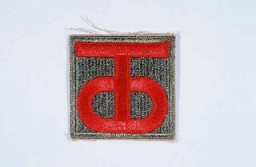
Insignia of the 95th Infantry Division. The 95th Infantry Division, the "Victory" division, gained its nickname from the divisional insignia approved in 1942: the arabic numeral "9" combined with the roman numeral "V" to represent "95." The "V" led to the nickname, since the letter "V" was universally recognized as an Allied symbol for resistance and victory over the Axis during World War II.
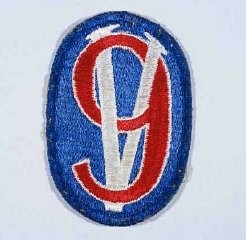
Insignia of the 99th Infantry Division. The 99th Infantry Division, the "Checkerboard" division, gained its nickname from the division's insignia. The insignia was devised upon the 99th's formation in 1942, when the division was headquartered in the city of Pittsburgh. The blue and white checkerboard in the division's insignia is taken from the coat of arms of William Pitt, for whom Pittsburgh is named. The division was also known as the "Battle Babies" during 1945, a sobriquet coined by a United Press…
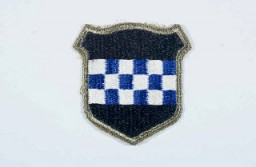
Insignia of the 9th Armored Division. Although no nickname for the 9th was in common usage throughout World War II, "Phantom" division was sometimes used in 1945. It originated during the Battle of the Bulge, when the 9th Armored Division seemed, like a phantom, to be everywhere along the front.
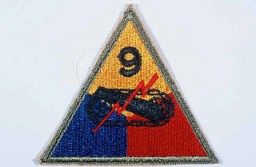
A notice posted on a wall in San Francisco, California, lists “evacuation” instructions for the area’s Japanese American residents, 1942. They were deported, first to temporary “assembly centers,” and from there to relocation centers in remote areas of the United States.
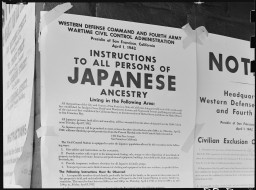
This group portrait shows instructors of the Hanoar Hatzioni Zionist youth movement at a summer camp in Lwów in 1936. The uniforms the young men wear, combined with the summer camp setting, bear similarities to the wider European scouting movement. Between World War I and World War II, scouting was very popular in Poland among young people. Scouting had a strongly national character. It inspired youth movements for Jews, who were excluded from scouting or who wanted to express their own national…
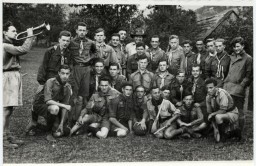
An elderly Yazidi woman tends to young children beside a half-constructed building in an internally displaced persons (IDP) camp where they live in Duhok, Iraqi Kurdistan. September 7, 2015.
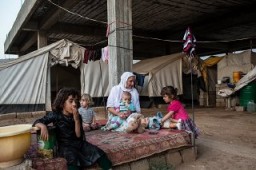
A Sunni man from Mosul, Iraq, prays as the sun sets over an internally displaced persons (IDP) camp near Erbil, Iraqi Kurdistan. September 2, 2015.
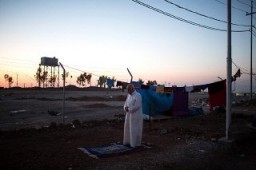
Offices of the International Criminal Tribunal for Rwanda (ICTR) in Arusha, Tanzania.
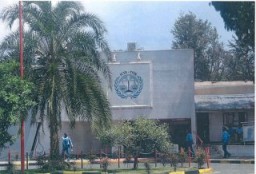
International Tracing Service (ITS) boxes containing documentation about Gross-Rosen. The archive was established by the Allied powers after World War II to help reunite families separated during the war and to trace missing family members. Bad Arolsen, Germany. Learn more about the ITS.
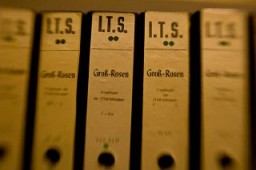
Roll call at an internment camp for Roma (Gypsies). Lackenbach, Austria, 1940–41.
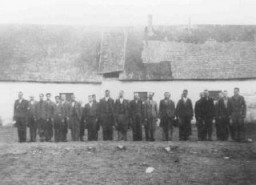
View of the interpreters' section in the courtroom during the International Military Tribunal. Nuremberg, Germany, March 29, 1946. The Nuremberg trials were an early experiment in simultaneous translation. The charter of the International Military Tribunal stated that the defendants had the right to a fair trial and that, accordingly, all proceedings be translated into a language that the defendants understood.
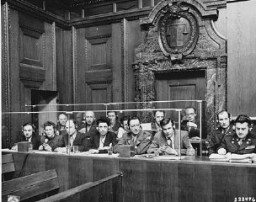
SS troops advance during the invasion of Greece. The invasion of the Balkans began in April 1941. Greece, wartime.

German Stuka dive-bombers fly over Yugoslavia during the German invasion of Yugoslavia, which began on April 6, 1941. Yugoslavia, ca. April 6, 1941.
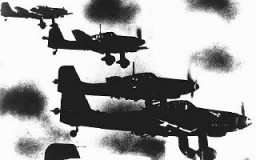
Members of a US congressional committee investigating German atrocities view the emaciated body of a dead prisoner at the Dora-Mittelbau concentration camp, near Nordhausen. Germany, May 1, 1945.
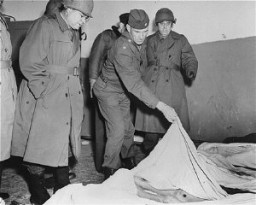
Former Romanian prime minister Ion Antonescu (center) before his execution as a war criminal. Fort Jivava, near Bucharest, Romania, June 1, 1946.

Portrait of Irena Sendler in Warsaw, Poland, circa 1939. Irena Sendler (1910–2008) was a member of the Council for Aid to Jews, codenamed “Żegota.” Żegota was a clandestine rescue organization of Poles and Jews in German-occupied Poland. Supported by the Polish government-in-exile, Żegota coordinated efforts to save Jews from Nazi persecution and murder. It operated from 1942 to 1945. Irena Sendler (Sendlerowa) was working as a social worker in Warsaw when World War II broke out in 1939. After…
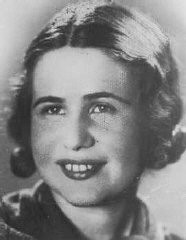
Portrait of Irmgard Huber, chief nurse at the Hadamar euthanasia killing center, in her office. The photograph was taken by an American military photographer on April 7, 1945.
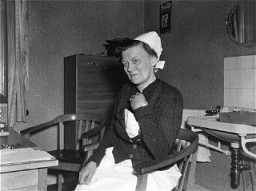
Israel Kanal, a member of the Akiva youth movement and a founder of the Jewish Fighting Organization (ZOB) in Warsaw. He fought in the Warsaw ghetto uprising. Kutno, Poland, ca. 1939.
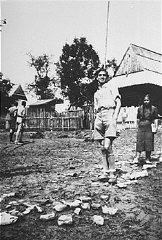
Thousands gather at the Roman Forum to listen to a speech by Italian Fascist leader Benito Mussolini. Rome, Italy, April 12, 1934.
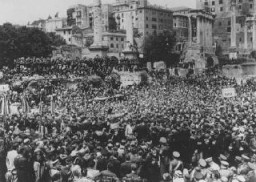
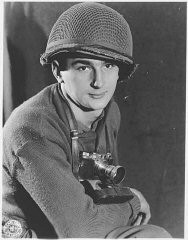
Postwar photograph of partisan Jack Kakis in Arta, Greece, 1950. After the German occupation of Greece, Jack escaped from a labor camp. He returned to Athens where he became involved with the underground movement, bombing factories, and writing anti-German slogans on the city streets at night. Eventually he joined the National Liberation Front, or EAM, and took to the mountains.
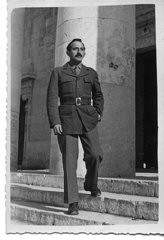
Jacob Edelstein, chairman of the Jewish council in Theresienstadt. He was deported, and shot in Auschwitz in 1944. Theresienstadt, Czechoslovakia, 1942–1943.
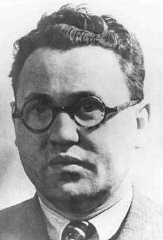
The Jacobsthal family poses with an aunt and uncle who are visiting their home in Amsterdam before emigrating to Chile. Amsterdam, The Netherlands, February 1938.

Concentration camp survivor Jadwiga Dzido shows her scarred leg to the Nuremberg court, while an expert medical witness explains the nature of the procedures inflicted on her in the Ravensbrück concentration camp on November 22, 1942. The experiments, including injections of highly potent bacteria, were performed by defendants Herta Oberheuser and Fritz Ernst Fischer. December 20, 1946.

Jan Karski and General Colin Powell meet during the opening ceremonies of the US Holocaust Memorial Museum. Washington, DC, April 22, 1993.
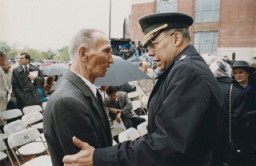

Jan Karski (standing), underground courier for the Polish government-in-exile. He informed the west in the fall of 1942 about Nazi atrocities against Jews taking place in Poland. Pictured in his office in Washington, DC, United States, 1944.
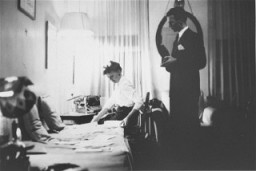
Photograph of Jan Zwartendijk with his daughter Edith and son Jan, Jr., Kovno, 1939-1940. Zwartendijk aided Jewish refugees by issuing permits for them to enter Curaçao, a Dutch colonial possession in the West Indies.

SS Second Lieutenant Gustav Willhaus, camp commandant, rides past the main gate of the Janowska concentration camp. The road from the street and into the camp was paved with tombstones the Nazis removed from Jewish cemeteries. Janowska, Poland, between September 1942 and November 1943.
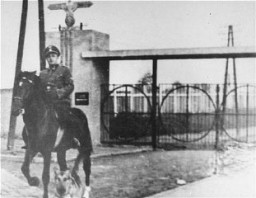
We would like to thank Crown Family Philanthropies, Abe and Ida Cooper Foundation, the Claims Conference, EVZ, and BMF for supporting the ongoing work to create content and resources for the Holocaust Encyclopedia. View the list of donor acknowledgement.